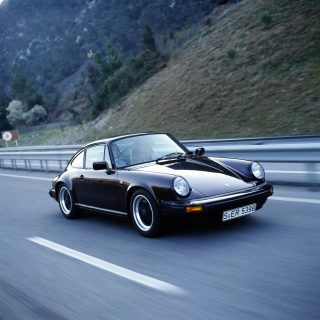#New #Porsche911#beyondcoolmag #Special #TimelessMachine #Generations
The original 911: the masterpiece from Zuffenhausen
On 27 November, the eighth generation of the Porsche 911 celebrated its world premiere in Los Angeles – 55 years after the debut of the original911 model. This is reason enough to take a look back at the previous seven generations:
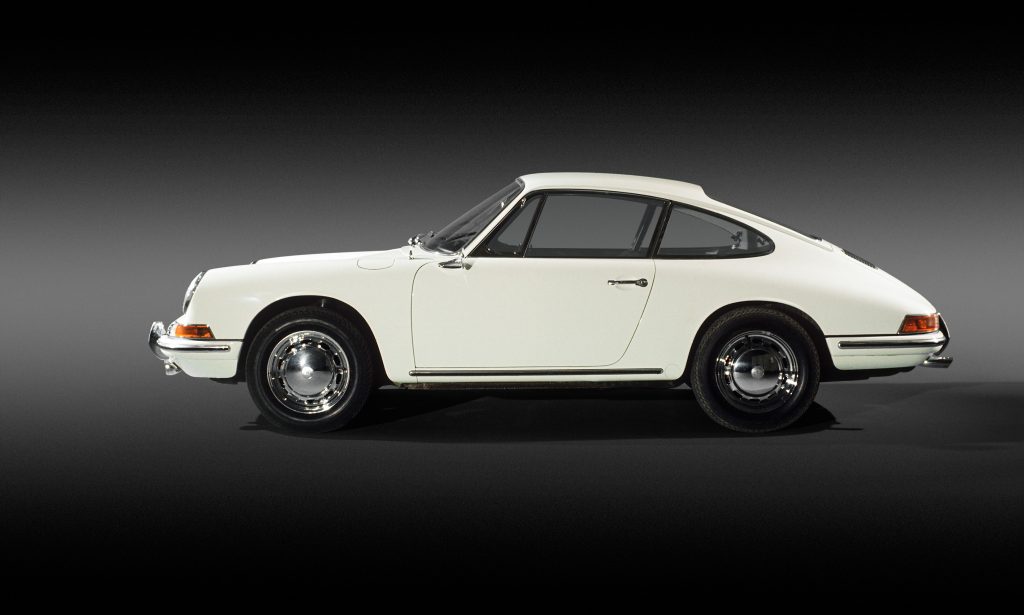
A legend is born at the International Motor Show Germany (IAA) in Frankfurt. It’s 12September 1963: Porsche proudly presents the eagerly anticipated successor to the356. The new sports car, originally known as the 901, is following in great footsteps.To reflect the ambitions of the brand, Porsche is now playing in a higher league withthe new model: a flat engine with six instead of four cylinders and air-cooled in the besttraditions of the company, but delivering 130 PS straight away. When the new modelcame onto the market in 1964 it was called the 911 – the result of a discussion aboutnaming rights with the automotive manufacturer Peugeot. The 911 is quickly accepted as a “genuine” Porsche because the performance of the new sports car exceeds all expectations. The stage is thus set for an unrivalled global career.

The expansion of the 911 model range then continued apace. In 1965, Porsche responded to a discussion in the USA that had branded cabriolets as dangerous in atypically pragmatic way: the company presented the 911 Targa as the first-ever “safetycabriolet”, featuring a roll-over bar that was a good 20 centimetres wide, a removable roof section and rear mini soft top. This was known as the soft window. This was followed shortly afterwards by a panorama rear window with heatable glass. The name of the open-top variant – “Targa” – was derived from the Targa Florio endurance racein Sicily, which Porsche had already won four times.

In 1966, another design icon celebrated its world premiere along with the 160 PS 911S: the #Fuchswheel. Probably the most famous wheel in automotive history entered new technological territory: being forged from one piece made it much lighter.

Additional model variants were ready in autumn 1967: the 911 T with 110 PS rounded off the range below the top model 911 S and the 911 E – the suffix “E” stood for petrol injection. This made it very clean: with these variants, Porsche was the first German car manufacturer to meet the strict US emissions regulations.
The continuous improvement of the 2+2-seater Porsche achieved a further milestone in the middle of 1968: from the 1969 model year, the wheelbase of the first 911 generation grew by 57 millimetres to 2,268 millimetres. Primarily, this gave the rear-engined sports car calmer handling. The 2.0-litre era ended in 1969: a four-millimetre larger bore increased displacement to 2,195 ccm. With the 1972 model year, the displacement increased even further to 2.4 litres, but the sports car was now also able to run on regular-grade petrol. Power ranged from 130 to 190 PS in the 911 S.
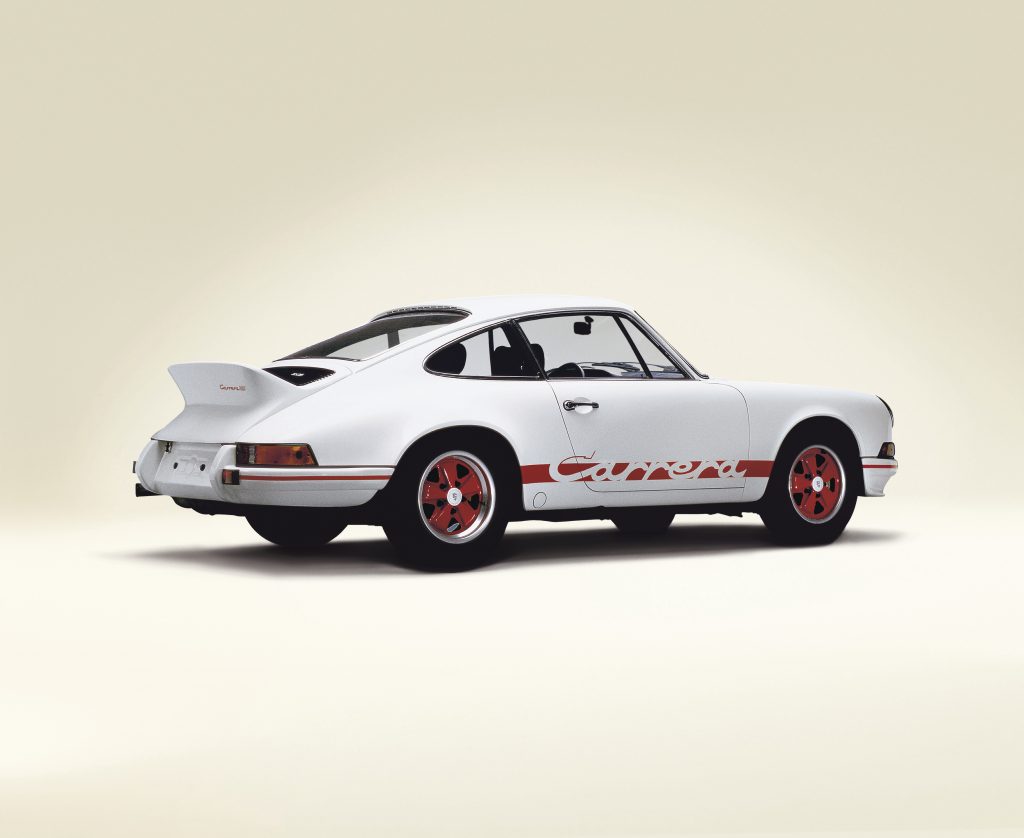
The 911 Carrera RS 2.7 became its very own legend with its “duck-tail” rear spoiler.This sports car weighed only 1,000 kilograms, developed a power output of 210 PS and had a top speed of over 245 km/h. In all, 1,525 cars left the factory gates in Zuffenhausen. This model therefore crowned the first 911 generation. A total of 111,995 original 911s were produced between 1963 and 1973.
The G model: The 911 gets off to a flying start with technical innovations

The 911 entered its tenth year in 1973 – with the most far-reaching changes that Porsche had made to its successful model series so far. The Stuttgart-based car manufacturer used powerful turbo engines in its top model and a galvanised body for every vehicle, and additionally launched a Cabriolet version of the 911 and the Speedster on the market in addition to the Targa. Its path to becoming an icon was now already clearly laid out at the latest.

However, the long-running model first had to prove how adaptable it was. The stricter safety regulations in the USA demanded that all new cars withstand a collision at eightkm/h without damage when driving forwards and reversing. Zuffenhausen therefore introduced the impact bumpers with rubber lip that are characteristic of the G model infront of the luggage compartment lid. These bumpers could be compressed by up to 50 millimetres without any damage to important vehicle parts. The collision energy was absorbed by flexible impact absorbers on the US version, and Porsche offered these as an option for all other markets. Moreover, safety in general was very important for the second 911 generation. This was shown by many details – from standard three-point seat belts and front seats with integrated head restraints through to impact surfaces in the newly designed sports steering wheels.

The six-cylinder engine in the standard 911 already featured the 2.7-litre displacement of the 911 Carrera RS of the previous generation right at the start. This increased to 3.0 litres shortly afterwards. As from 1983, this even increased again to 3.2 litres, with a power output of up to 250 PS for the 911 SC RS. The enormous development potential of the air-cooled flat engine meant that there was always room for more surprises.
The 3.0-litre flat engine at the rear of the 911 Turbo reached much higher power levels as from 1974. The turbocharger technology adopted from motor sports initially powered this super sports car with 260 PS. From 1977 onwards, an additional intercooler and an increase in displacement to 3.3. litres provided an extra boost – the result was an impressive 300 PS. This translated into performance values that were practically unrivalled in the middle of the 1970s: 5.2 seconds for the sprint from zero to 100 km/h was just as unbelievable as a top speed of more than 260 km/h. Another legend was born with the Turbo.

Nevertheless, dark clouds were gathering on the horizon: new sports cars from Porsche with transaxle technology (engine at front, transmission at the rear axle) such as the 924 and 944 model series with four cylinders and the 928 series with eight cylinders were intended to step into the footsteps of the 911. However, the transaxle heirs to the 911 throne did not establish themselves and the demand for the evergreen remained as high as ever. Porsche then took the right decision: a change in strategy. The future of the 911 was therefore secured for the time being. As from 1982, a Cabriolet version was also offered for the first time alongside the Coupé and Targa. This was even followed by a 911 Carrera Speedster in 1989, marking the end of the second 911 generation – 2,103 of these were delivered with the turbo-width body and only 171 in the slim export version. The G model was built in the period between 1973 and 1989, and Porsche produced 198,496 of these vehicles during these 16 years
The type 964: a new start with this 911.
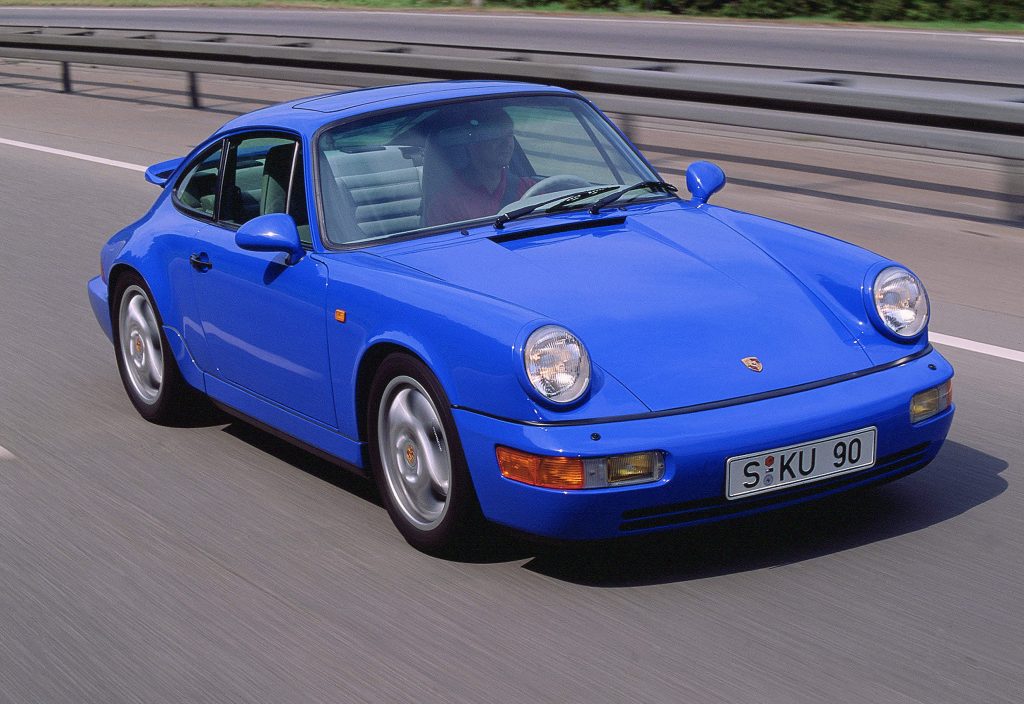
The third generation of this sports car, known internally as the type 964, combined the traditional silhouette of the classic model with state-of-the-art technology. It was also a bet on the future of the company, which was experiencing economic challenges – a bet that this third generation would win.
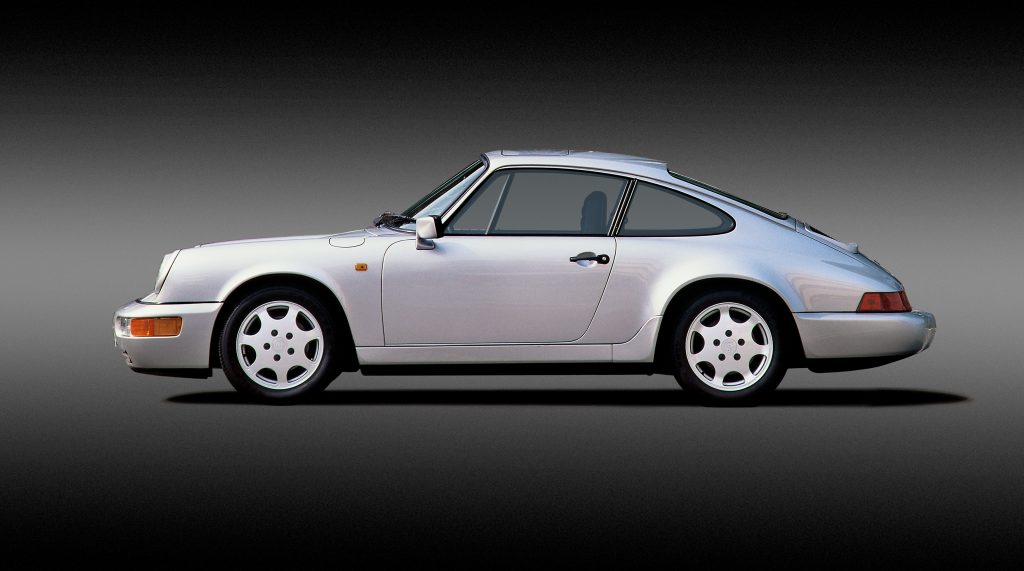
The first model variant immediately showed just how advanced the new 911 was: an all-wheel drive that Porsche had originally designed for the high-performance sportscar 959 was introduced to the series for the first time on board the Carrera 4. With electronically controlled and hydraulically regulated power distribution, it was well ahead of its time. The all-wheel-drive system used the sensors of the anti-lock braking system (ABS) which – just like power steering – then became fitted as standard in this model, rather than being an optional extra.
The 911 Carrera 2 with rear-wheel drive followed in 1989. At the same time, the Cabriolet and Targa versions also celebrated their debut alongside the Coupé. What’s more, under that familiar body – in practice only modified by having integrated bumpers– 85% of the 964 also consisted of newly designed parts.

At 3.6 litres, the air-cooled flat-six engine reached new heights in terms of displacement, and delivered 250 PS in the Carrera 2/4 models. One of the technical innovations in the boxer engine was its twin-spark ignition, which Porsche had originally developed for greater operational reliability in aircraft engines. At the same time, the aerodynamic lift at the rear axle was almost completely eliminated due to the rear spoiler now being retractable. And there was another new feature: the adaptive Tiptronic gearbox, which allowed smooth gear shifting without any interruption in power.
The 911 Jubilee model was one of the most distinctive variations of the 964 generation,with only 911 of these special, limited-edition cars to mark 30 years of the 911 made available on the market in 1993 – and they sold out quickly. With wide wings at the front and rear, this model combined the drive unit of the Carrera 4 with the Coupé body and chassis with 17-inch-wheels of the 911 Turbo, but came without its rear wing. Porsche combined the exclusive exterior colour Viola Metallic with a full leather interior in Rubicon Grey.
Adding to the exclusivity, the 911 Speedster was launched in 1993 with a shortened windscreen, modified roof structure, and signature double-bubble cover behind the front seats. 930 cars were built on the basis of the Carrera 2 Cabriolet, plus a further 15 vehicles with a wide turbo-look body.

The turbocharged versions were the top-of-the-range 911 type 964 models. The 911Turbo initially adopted its predecessor’s 3.3 litre engine, which at that time produced 320 PS, and the 911 Turbo S engine delivered an impressive 381 PS. The model was switched to the new 3.6-litre engine with 360 PS at the start of 1993, and the next inline was already knocking at the door from October of that year, and so the sports car icon took the next step. Porsche produced a total of 63,762 type 964 vehicles between1988 and 1994.
The 993: Pinnacle of the air-cooled era and the last of its kind
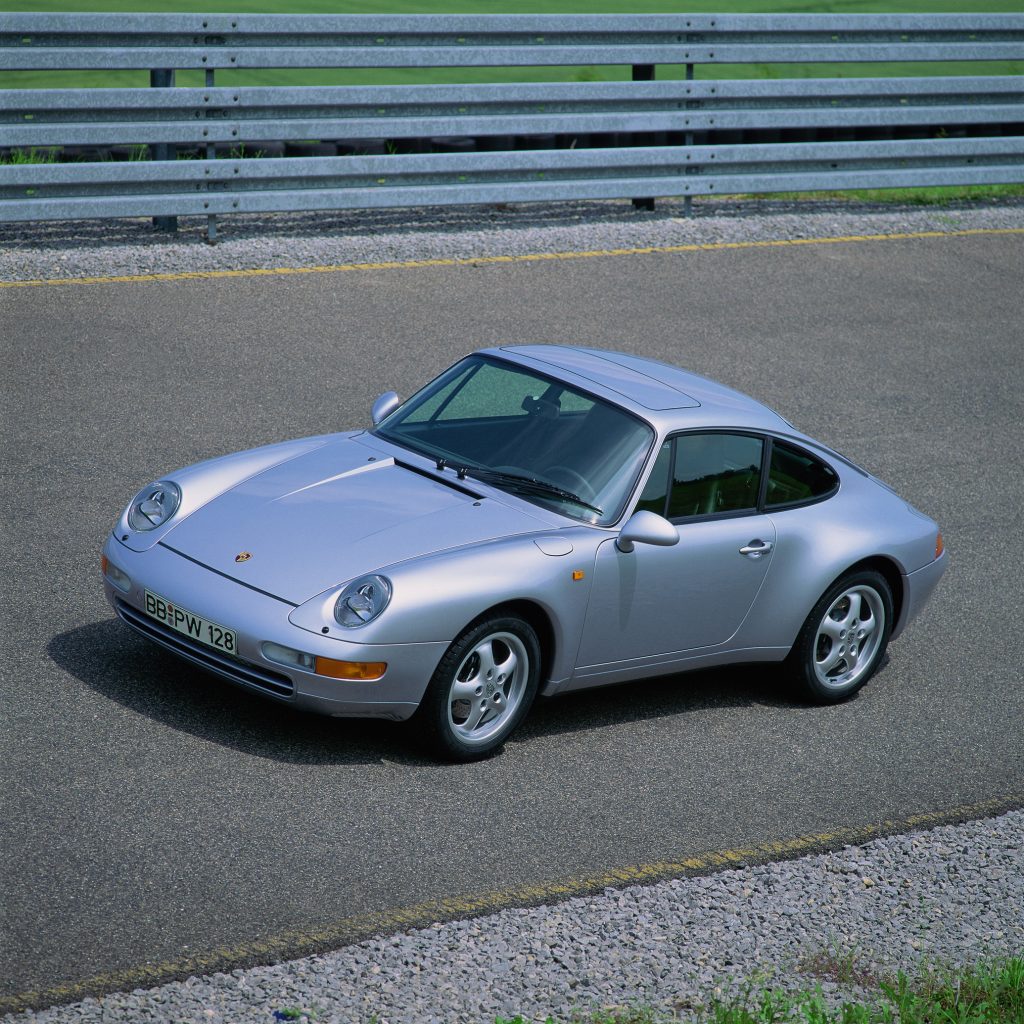
One thing is certain, and not just for fans of sports cars from Zuffenhausen: the fourth generation of the 911 – the 993 – is one of the most desirable editions in the history of this classic vehicle. Although practically only the roofline remained unchanged, the newmodel impressed with an exciting interpretation of the 911 design DNA beginning in 1993. The natural interplay of concave and convex forms, integrated bumpers, flush-mounted windows and the wide rear end with its angled tail-light panel set the hearts of almost all sports car enthusiasts aflutter. Even the new front wings – a flatter design made possible by new polyellipsoid headlights – quickly found widespread approval.

The 993 also underlined its leading position in the sports car segment with its technical features – such as the completely redesigned LSA aluminium chassis, which combined lightweight construction, stability and agility. Up to the present day, the multi-link suspension is considered to be the ultimate development stage of the “Weissach” rear axle, which made history with its self-steering properties. The result: even better driving dynamics and enhanced suspension comfort.
The new generation also set standards with its drive unit: the 911 Turbo with standard all-wheel drive came with two turbochargers in 1995. The effect: outstanding 408 PS.

At the same time, the 3.6-litre biturbo engine impressed with the lowest exhaust emissions of all series-production units at the time. At the rear of the two-wheel-driven #911GT2 – and limited to an edition of 100 – it even produced up to 450 PS.
Initially, Porsche offered the 993 only as a Coupé and Cabriolet. The Targa did not make its debut until 1995, at which time it arrived with a new concept: Instead of a removable hardtop, it had a broad electric glass roof which slid under the rear window.There was also another body variant as a series-production model: the all-wheel-drive Carrera 4S – followed slightly later by the Carrera S – combined the wide body and chassis of the 911 Turbo. Only the rear wing was omitted.

The flat-six engine provided another reason why the 993 is so popular among collectors and fans: it was the last 911 unit to feature classic air cooling. Initially with a power output of 272 PS, the two-valve model – again equipped with twin-spark ignition – already delivered 285 PS from 1995 onwards. Porsche also optionally offered a 300 PS variant. The manual transmission was also new: with a top speed of now up to 270km/h, it received a sixth forward gear to cover this speed range without curtailing the engine’s power development due to a long ratio. The gear changes were also once again more precise.
In the end, staking everything on the 911, Type 993 paid off for Porsche. The chapter of air-cooled engines in this unique model history ended with the fourth generation of this iconic sports car in 1998. The second era then started after 35 years. It was the beginning of a time that would see unparalleled success. For the 911. And for Porsche.Porsche produced a total of 68,881 vehicles of the Type 993 between 1993 and 1998.
The 996: First 911 with water-cooled flat engine.
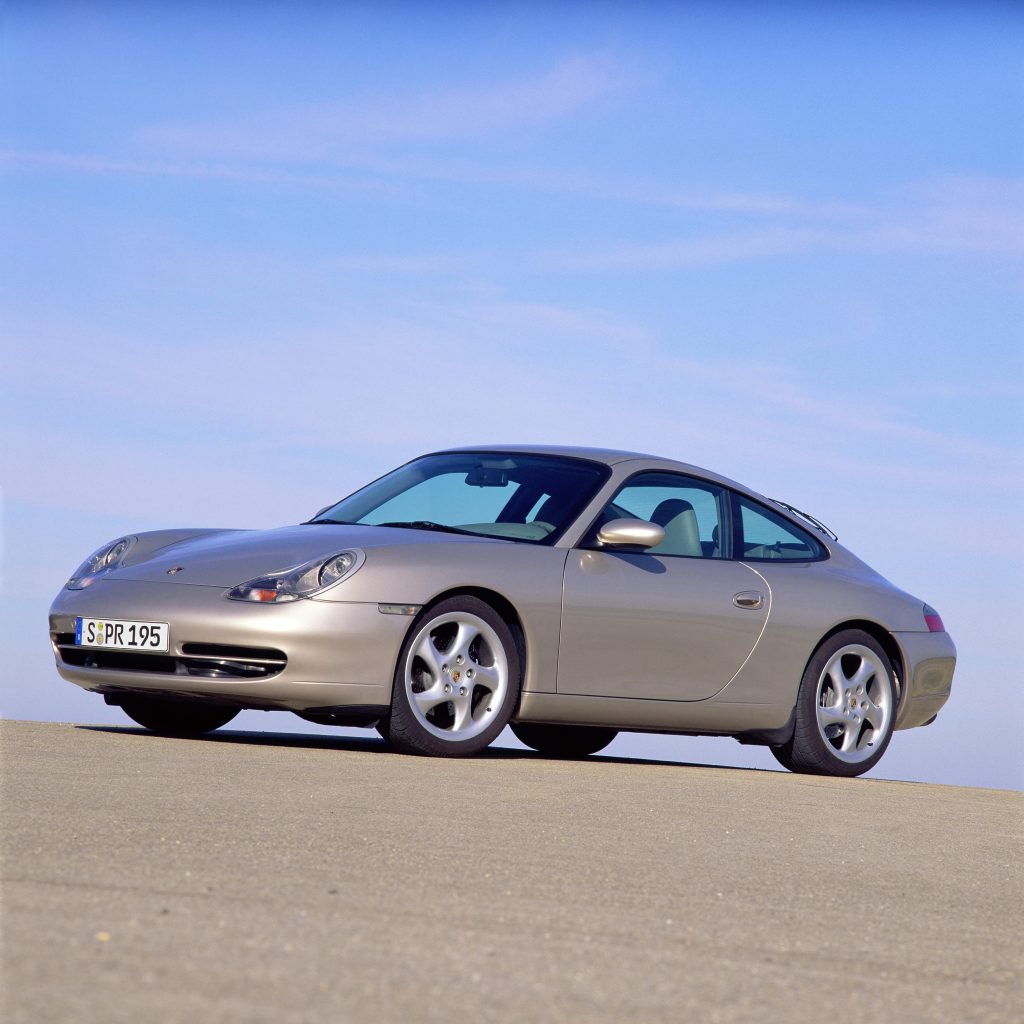
With the fifth generation of the 911 introduced in 1997 – the type 996 – Porsche took the bold step to stop using air-cooled engines. After 34 years, the sports car manufacturer completely revamped its icon with the new 911 and in doing so solved a number of urgent challenges. As part of a process that had started with the predecessor, the focus was on reducing production costs through maximum compatibility of parts with other model series, such as the Boxster, as well as on meeting updated safety and emissions regulations. Porsche found its path into the future with the 996.
It did this by preserving classic proportions and combining them with modern technology – in short, reinventing a sports car legend and preparing it for the future. The 996 had a difficult legacy to follow, but it also represented the first chapter of a new era. That was already clear in the design.

The result was a newly developed body, which impressed with an elegant, no-frills look. The dimensions also grew: The new 911 was now 18.5 centimetres longer, and the wheelbase was also lengthened for the second time in the history of the model series. This increased by 80 mm, while the body width also added another three centimetres. The interior also benefited from these changes: the 996 offered more elbow room and a more generous feeling of spaciousness. The dashboard also had a newlook: the five round instruments merge into each other – another break with tradition.

However, the greatest revolution was at the rear. The flat engine design was preserved– but not its air cooling, because this cooling principle did not have enough reserves to comply with the increasingly strict emissions regulations. In contrast, the newly developed water cooling system was ready for the future. This was also true for its performance: the four-valve six-cylinder engine generated 300 PS from a displacement of 3.4 litres, therefore matching the legendary 911 Turbo 3.3. After the engine facelift with a displacement of 3.6 litres, this increased to 320 PS, and in the anniversary edition“40 years of Porsche 911”, the power output even reached 345 PS.
The 911 Turbo also received a new water-cooled flat engine. This came with an impressive track record: as a 3.2-litre six-cylinder engine, it had already powered the #911GT1 to victory in the Le Mans race in 1998. Thanks to twin turbocharging, it delivered 420 PS in the series-production vehicle. This 911 Turbo was therefore the first series model from Porsche to break the 300-km/h barrier. In the #911GT2, the unit even produced up to 483 PS. The #PCCB with ceramic brake discs also made its debut in the extreme sports car and was standard equipment in the GT2. This was 50 percent lighter than the brake with standard brake discs and had a service life of up to 300,000 kilometres.
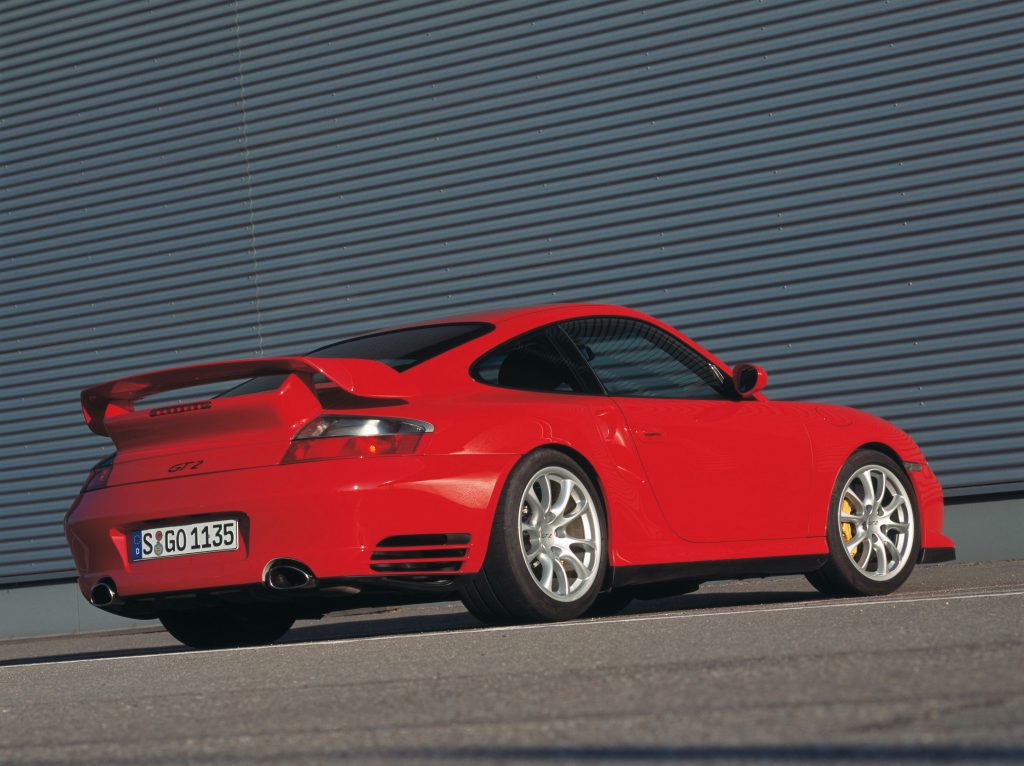
With the same engine but without turbocharging, the 911 GT3 marked the start of a new era: it offered pure driving pleasure both on the road and on the race track as part of #TrackDays. It also formed the basis for the Porsche brand cups, and was the starting point for many race victories of Porsche customer motorsport all over the world. In the #996, the 3.6-litre naturally-aspirated engine initially had an output of 360 PS, and then 381 PS. The 911 #GT3RS followed in 2003 as an even sharper edition. Between 1997and 2005, Porsche produced a total of 175,262 Type 996 vehicles.
The 997: Technology offensive, new design and great variety for the 911

From 2004, the Porsche 911 was available in more different versions than ever before: Customers could choose from a Coupé or Targa, Cabriolet or Speedster, rear- or all-wheel-drive, narrow or widened bodywork, with water-cooled naturally-aspirated and turbo engines, a #GTS or the #GT2, #GT2RS or #GT3 sport versions, or either of two #GT3RS models. Including special models, the range had a total of 24 model variants –supplemented by a wide range of personalisation options.

With the design of the type 997, Porsche made the 911 even sharper thanks to a more dynamic and powerful look. The Carrera was already noticeably more masculine with more pronounced shaping of the rear end, while the width of the S, GT and Turbomodels grew by 44 millimetres. The type #997 set itself apart from its predecessor by the steeper, round clear-glass headlights, marking a return to an important style element of the air-cooled 911 models. After the facelift in July 2008, the front end featured bi-xenon headlights and LED daytime running lights.

The 997 generation of the Porsche 911 also set new benchmarks on the technical side as well. The 3.6-litre six-cylinder engine of the Carrera initially produced 325 PS. The cylinder bore was increased by three millimetres for the S models. With a displacement of 3.8 litres, this became the largest flat engine in a series-production 911 thus far.
For the model update in 2008, Porsche thoroughly revamped the engine range and introduced direct fuel injection for the first time. The fuel consumption and emissions fell significantly as a result, but the performance figures shot upwards: 345 PS for the 3.6-litre version, 385 PS in the 3.8-litre six-cylinder model. The new 911 #Carrera GTS,which closed the gap between the S models and GT3, even produced 408 PS.
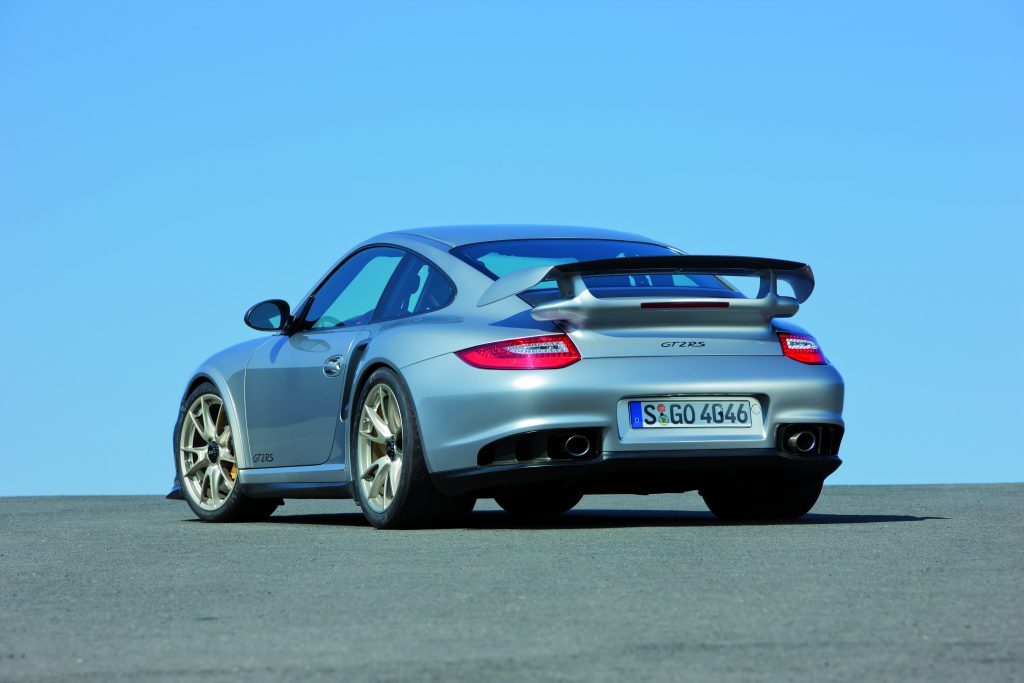
The #911Turbo also benefited from the technology offensive: Its 3.6-litre engine was the first petrol engine to be equipped with a turbocharger with variable turbine geometry. The later changeover to a displacement of 3.8 litres and direct fuel injection permitted an initial leap from 480 to 500 PS. The 911 Turbo S even came with 530 PS,combined for the first time as standard with a seven-speed dual clutch transmission. Only the 911 GT2 RS was faster and more powerful. Its engine developed 620 PS,enough for a lap time of 7:18 minutes on the #Nuerburgring #NorthLoop.
The GT3 models also benefited from increased power, from initially 415 to 435 PS. The RS 3.8 even delivered 450 PS. However, the crowning achievement was the GT3 RS 4.0. This vehicle, produced in a limited edition of 600 units, generated 500 PS.
The 997 generation also featured a number of remarkable special edition models, suchas the 911 Sport Classic. Each of the 250 units in the edition found a buyer within just48 hours. The 911 #Speedster – also with a power output of 408 PS – was offered byPorsche in a limited series of 356 units. The 911 Turbo S Edition 918 Spyder was a special case: this model was designed to shorten the waiting time of the future owners of a new #918Spyder before they took delivery of their hybrid super sports car – only these 918 happy customers were able to order the special-edition model. Porsche pro-duced a total of 213,004 sports cars of the type 997 between 2004 and 2012.
The 991: the 911 passes the one million mark.

From 2011 onwards, the Type 991 represented the most technically advanced 911 model to date. The 991 looked more powerful than any other 911 before – an effect that was heightened by the wider track and a wheelbase stretched by ten centimetres.It also featured adaptive aerodynamics: the 911 was the first series sports car from Porsche to adopt this technology from the 918 Spyder hybrid super sports car.
The newly designed interior of the 991 was based on the architecture of the #CarreraGT. It combined classic 911 elements such as the five round instruments – one as a high-definition multifunction display – with modern design and enhanced ergonomics.At the same time, the new Porsche Communication Management (PCM) was introduced with improved connectivity, multitouch monitor and real-time traffic information.

The brand icon was more athletic and more powerful than ever before. The lightweightbody in aluminium-steel design was again more rigid and helped to reduce the weightby 45 kilograms. The entry-level six-cylinder engine made do with a displacement of 3.4 litres, but still developed 350 PS. The S models produced 400 PS from 3.8 litres,and the #GTS even delivered 430 PS from the same displacement.

Following the new edition of the 991 launched in 2015, the 911 Carrera models also relied on the power of two turbochargers. In combination with a three-litre engine, the power outputs of the three Carrera versions, standard, S and GTS, were now 370, 420 and 450 PS respectively. A 911 Carrera accelerated from zero to 100 km/h in less than four seconds. The fuel consumption and exhaust emissions were reduced.
The available power also reached new dimensions with the Turbo and GT variants,with no less than 700 PS in the 911 GT2 RS. With a top speed of 340 km/h, this was the fastest series-production 911 in the model history. The 911 GT3 RS with 520 PS from its 4.0-litre high-speed naturally-aspirated engine featured more motorsports technology than Porsche had ever before offered in an on-road vehicle.

A highlight of the model range was the 911 #Targa, which incorporated the classic idea of this concept with a wide bar instead of the B pillars, and combined this with a clever roof design. Other highlights were model variants such as the weight-optimised #911CarreraT, the extremely lightweight #911R, which was produced in a limited edition of 991 vehicles, as well as the 911 GT3 RS with a weight of only 1,370 kilograms. The special-edition model “50 years of 911” was also highly coveted, with exactly 1,963units being built. An important place in the company’s history is occupied by the Irish Green sports car with numerous exclusive features which rolled off the production line in Zuffenhausen on 11 May 2017: the one-millionth 911. The 450 PS jewel remains inthe ownership of Porsche AG.
The 991 generation of the 911 was the absolute best seller for Porsche. 217,930 unitswere built in the period from 2011 to 31 October 2018 and counting. In total, Porsche has produced 1,049,330 series 911s since its debut in 1963 to end of October 2018.
-Ends-
Images and video Porsche AG


